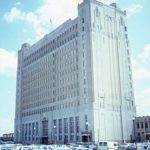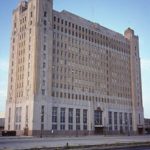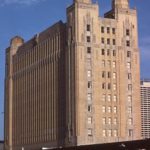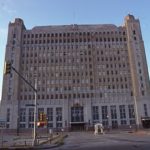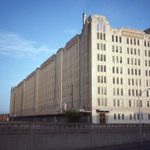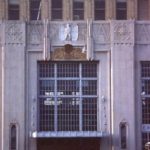The Texas & Pacific Railroad played a central role in Fort Worth’s development, from the establishment of the city’s first rail line in 1876 to the peak years of train service during World War II. Fort Worth’s growth in the oil-boom years of the 1920s outstripped its transportation facilities. Beginning in 1928, Texas & Pacific President John L. Lancaster met with the Fort Worth City Council, under the leadership of Mayor William Bryce, to address the problem. In June of 1929, Lancaster and Bryce announced an ambitious joint plan in which the railroad and the city would, in essence, reconstruct the downtown rail and road system. The T & P proposed to expend $3,000,000 to construct new passenger and freight terminals. The city would spend a like amount for the construction of a network of street underpasses to accommodate relocated tracks; a municipal bond election secured these funds.
The Fort Worth architectural firm of Wyatt C. Hedrick received the commissions for the terminal buildings. Hedrick was a major architect of his day who was involved in the design of numerous important buildings in Fort Worth and Texas. The chief designer for the terminal building was H.P. Koeppe; chief engineer was P. M. Geren.
Bids were advertised for in early 1930 and contracts awarded in April. Total bids amounted to $1,342,899 for the passenger terminal and $1,720,000 for the freight terminal buildings. P. O’B. Montgomery of Dallas was the general contractor. Work commenced that summer. The passenger terminal opened formally on November 2, 1931, with a gala Rail-Banquet. The freight buildings were completed presumably about the same time.
The passenger terminal followed the precedent of earlier British and American train stations, with an office block rising above the station. It is of reinforced concrete and steel-frame construction, clad in yellow-buff brick, with polished red granite and limestone base and limestone trim. In plan, it is a rectangle measuring approximately 70′ by 222′. The building’s design incorporates a three-part vertical composition. From the high ground floor with mezzanine base rises a ten-story shaft, the top two stories of which are slightly recessed. Major frieze bands of carved limestone are set above the base and eighth story and at the cornice. Projecting end bays at each corner of the building step back at the eighth story and terminate above the roof level in peaked octagonal towers. Recessed spandrel panels and continuous piers emphasize the impression of verticality. The high ground floor, lit by panels of small-paned windows, is comprised primarily of waiting rooms, restaurant, and an elevator lobby, all richly finished. Interior and exterior ornament exhibits abstract geometric and plant motifs in the Art Deco style. Train sheds and a trucking platform were built at the same time.
The freight terminal is situated west of the passenger terminal building, across Jennings Avenue. It consists of two buildings. The infreight warehouse is an enormous 8-story masonry block measuring 100′ by 600′ of reinforced concrete and steel-frame construction, clad in yellow-buff brick with limestone trim. As with the passenger terminal building, projecting end bays terminate the octagonal towers; unlike the former, these are squat and elongated, with flat tops. Each long façade is divided into five bays by paired piers, with minor piers and recessed spandrel panels in each bay accentuating the verticality suggested by the corner towers. Continuous loading docks covered by metal canopies extend along the long sides. Ornament is restricted primarily to patterned red brick friezes above the ground floor, similar frieze panels along the cornice, and limestone coping along parapets. The outfreight warehouse, with similar materials and trim, is a long one-story structure terminated by a two-story block at each end. It is situated behind the larger structure. The dominance of the infreight warehouse suggests Fort Worth’s importance as an importer of goods for local distribution. The region’s primary export items — oil, meat and grain — generally were shipped via separate rail facilities.
The complex of buildings is an architecturally impressive monument to the importance of the railroad in Fort Worth’s development. However, the automobile has dominated passenger travel since the 1950s; train service to the passenger terminal ceased in 1967. The building was sold by the Texas & Pacific Railroad in 1977, and today is occupied by federal and private offices. Similarly, trucks haul most freight today, and the freight terminal buildings are under-used. The location of the elevated 1-30 freeway next to the buildings, visually severing them from downtown, is symbolic of the ascendancy and dominance of the new mode of transportation.
In 1978, all three structures were placed on the National Register of Historic Places, and in 1980, the passenger terminal building was designated a Recorded Texas Historic Landmark.
The Fort Worth Transportation Authority gained ownership of the Terminal Building’s “Main Waiting Room” and “White Women’s Waiting Room” under a condominium agreement. The Fort Worth architectural firm of Gideon Toal directed the restoration of these two rooms. The general contractor was Beckman Construction who enlisted the services of subcontractors and artisans to restore the rooms, including the highly ornamental ceilings, to their original appearance. The restoration was completed in 1999. The project received numerous awards from local and state organizations.
The upper floors of the Terminal Building have been rehabbed into one- and two- bedroom condominiums and a new condominium building, designed by Womack + Hampton Architects, LLP, was constructed to the east. Its construction necessitated the demolition of a portion of the historic parking structure and canopy behind the building.
The elevated freeway in front of the buildings was removed in 2003, reconnecting the buildings with the southern edge of the central business district and spurring the redevelopment of Lancaster Avenue.
The Texas and Pacific Warehouse was designated as Highly Significant Endangered in 1995. It continues to suffer from neglect and deterioration.
The outfreight warehouse, pictured to the left, has been demolished.

